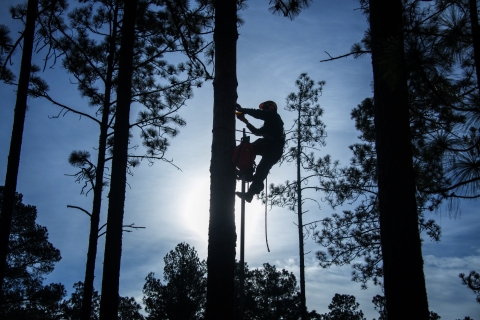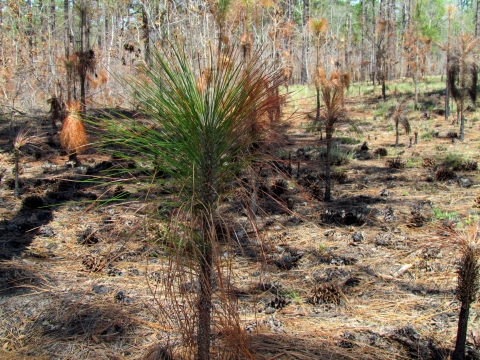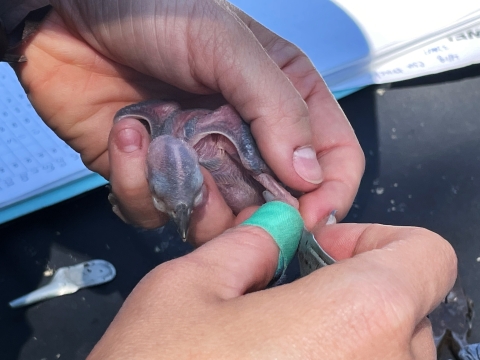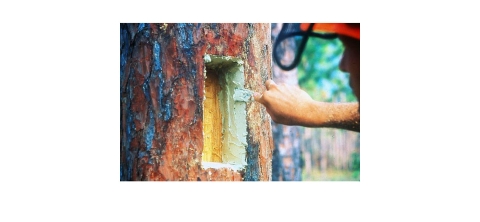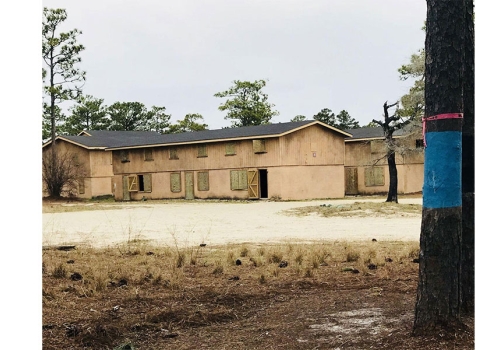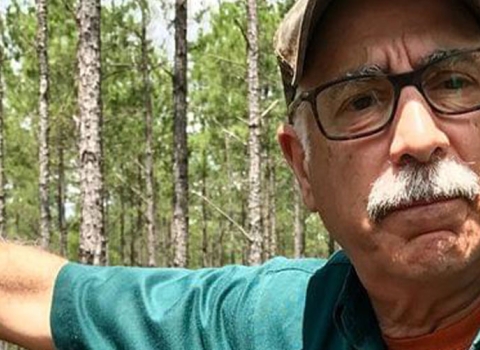Valparaiso, Florida – It was getting dark. A light rain fell. Distant thunder rolled across the steamy, early-fall sky. The hunters were apprehensive. Their prey: endangered red-cockaded woodpeckers.
“You don’t want to come back without a bird,” said Patty Kelly, a biologist with the U.S. Fish and Wildlife Service in Florida.
But the woodpeckers at Eglin Air Force Base weren’t to be killed; they were to be “translocated” – captured from pine tree cavities, placed in wooden boxes and driven overnight to populate another Southern forest. The sunset hunt was a celebration of sorts, an acknowledgement that the birds that almost disappeared have rebounded nicely enough in this corner of Florida, at least, to be shipped elsewhere to further propagate the species.
The Service is currently studying the bird’s overall health in the wild to determine if it can live happily ever after without federal oversight. A draft of the so-called Species Status Assessment should be ready by year’s end.
Today, 7,200 active clusters, or male-female pairs of birds, exist from Virginia to Texas. In 2003, there were 5,600 clusters.
While it’s too soon to declare victory, and delist or downlist RCWs from the endangered species list, biologists credit federal and state agencies, the military, nonprofit groups and private landowners for the bird’s recovery.
“With few exceptions, the woodpecker is coming back strong,” said Will McDearman, who heads up Service efforts to rebuild RCW numbers. “It’s all testament to close cooperation between property owners, the conservation community and the scientists who know where the birds are and where they should go.”
Still, challenges remain. RCWs are under assault from urbanization, commercial forestry, agricultural expansion, burning restrictions, budgetary pressures and a warming climate. Consequently, there were no guarantees that Kelly and the other woodpecker hunters would bag their prey.
“Sometimes they won’t ever leave the tree, but we usually get a couple of shots,” Kelly said. “The trick is getting to the tree before the bird hears you.”
Bagging the birds
An hour later, Kelly, Bruce Hagedorn, the natural resources chief at Eglin, and Jennifer Manis, a Florida Wildlife Commission biologist, were squatting surreptitiously in the middle of a prescribe-burned forest filled with longleaf pine, live oak, yaupon holly, saw palmetto and wiregrass. They focused on an empty hole 18 feet above ground in a longleaf pine that had been pecked through to its core. And they waited.
The hard work had already been done. Aliza Sager, a biologist, consultant and translocation expert, started monitoring RCW clusters in March, traipsing around Eglin’s 405,000 acres of forest. She looked for clusters with at least two adult RCWs and enough trees with already-dug cavities suitable for baby birds. Sager compiled a list of 125 clusters to monitor during breeding season.
By mid-April she began checking nests with a telescoping pole and peeper camera. Babies between five and 10 days old were extracted and banded. Two weeks later, Sager returned to begin identifying each bird’s sex.
She spent the hot, sticky Panhandle summer observing her birds and making certain which were male or female. She identified the trees that 10 males and 10 females called home and flagged the trees for Kelly and the seven other teams of woodpecker catchers scattered across Eglin waiting for the sun to go down and the birds to come home one last time.
At 5:34 p.m., a bird chirped.
“There it is,” whispered Hagedorn, leaning against a dead tree with binoculars at the ready. Thunder rumbled closer by.
Two minutes later, the RCW entered the exact cavity Sager had identified. Was it the female they were targeting, or another bird? Hagedorn and Kelly didn’t have enough time to read the band. Should they capture the bird and then determine its sex?
Too late. The voluble bird exited the cavity and joined another in conversation.
At 5:40 p.m. the RCW returned to the roost. A loudspeaker at an airfield a few miles away warned of lightning. Time was running out.
Kelly jumped into position at the tree’s base. She extended her telescoping pole with camouflage net to the cavity. Hagedorn thumped the tree with a log. The bird flew into the net and captivity. Kelly lowered the pole, gently grabbed the RCW, matched its band with Sager’s notes and put the female bird into a wooden, aerated box.
It was 5:46.
“Bruce and I still have it,” said Kelly, exhilarated. “I’m so relieved. The stress is over.”
“This was my Super Bowl”
More than 1 million woodpecker clusters once populated the 90-million acre longleaf pine ecosystem that stretched from New Jersey to Texas. Timber and turpentine harvests, as well as sprawling urban and agricultural lands, decimated the bird’s territory. Southern forests today – mostly commercial pines with insufficient fire and habitat – aren’t kind to the woodpecker either.
The bird was listed as endangered in 1970. Maybe 3,000 RCW clusters existed at the time, though few good surveys were done. The future of the woodpecker – whose only distinguishing red markings are a few feathers mostly hidden underneath black and white feathers near a male’s cheek – looked bleak.
But the RCW is a plucky little 7-inch bird, quite deliberate and family-oriented. He’ll spend up to three years excavating a cavity in a mature pine tree typically infected with a fungus known as red-heart disease that softens the tree’s interior and makes for a cozy home. He’ll keep pecking holes in the bark to ensure a steady flow of sticky pitch around the cavity to inhibit the approach of rat snakes and other predators.
Woodpeckers are very social and forage together for insects. Male “helper” birds stick around to assist in child-rearing. They love to hang out and chat – or “sklit” (when disturbed), “churt” (when entering a roost) and “chortle” (when insect-hunting together).
The Service and friends set about saving RCWs in the early 1990s. The Southern Range Translocation Cooperative, a sort of woodpecker trading cartel where bird-poor regions seek woodpeckers from bird-rich regions, was created in 1998. More than 1,000 birds have since been translocated.
“This really is a conservation success story,” Hagedorn said. “When I first started attending the cooperative in 1998 there was way more demand for birds than there were birds available. Over the last few meetings, though, there were more birds available than people needing them.”
It was at last fall’s cooperative meeting where the Talladega National Forest in Alabama learned it would receive 12 birds this year. Most of the birds came from Eglin; some came from Fort Benning near Columbus, Georgia. All would help replenish a flock that had dwindled to maybe a half-dozen birds in the mid-90s.
By 9:30 p.m. the Eglin birds were re-tagged and readied for the five-hour, overnight drive to northeast Alabama. Sager, the woodpecker biologist, was exhausted. And ecstatic.
“This is my Super Bowl,” she said. “Twenty birds was my goal. We hit it.”
“We started pumping birds in”
Jonathan Stober and his precious cargo drove nearly 300 miles through the night to the Talladega forest and the RCWs’ new home. Stober, a U.S. Forest Service biologist, arrived at 3 a.m., left the quiet, yet confused birds in the truck and bunked down in a nearby office for a short nap.
Stober travels the South each year receiving translocated RCWs and rebuilding
Talladega’s stock. Only two or three active clusters remained at the northeastern Alabama forest in the mid-1990s.
“The population in Talladega was on the brink,” Stober said. “So we started pumping birds in here from Fort Stewart, Fort Benning, Apalachicola and Oakmulgee. We want critical mass to sustain them well into the future.”
Talladega today tallies 27 clusters with maybe 55 to 70 birds. Stober aims for 100 birds within two years.
Southern military bases, with vast expanses of forest and well-regarded conservation programs, remain key woodpecker donors. A decade ago, Eglin hit its RCW recovery goal of 350 clusters. Today, more than 500 clusters thrive at the sprawling air base home to jet fighter squadrons and special operations forces.
Private landowners deserve credit as well for the woodpeckers’ revival. Via the Service’s voluntary Safe Harbor Program, property owners can work their RCW-friendly land without fear of future regulatory action if woodpeckers take up residence.
The birds are slow cavity-builders so man-made nests also boost RCW numbers. Biologists with chainsaws cut rectangular holes in old pine trees and insert a “nest box” about 25 feet off the ground. Or they’ll just drill a cavity the size of a 16-ounce beer can. Bark around the artificial nests is scraped smooth so predators can’t gain traction.
Stober released his birds below manmade cavities. He had awoken at 5:30 a.m., drove up into the Shoal Creek Ranger District and readied to release his befuddled prey. First, he had to rip the screens from the artificial nests via long strings. Success would be measured sometime next year by the RCWs moving into the cavities, hooking up and propagating the endangered species.
Stober released a female at 6:36 a.m. and a male a minute later. They flew to the same tree and began a heated discussion. You can imagine what they said:
He: Where the hell are we?
She: I have no idea.
He: What a night. Cooped up in a box for 12 hours. And no grubs.
She: I’m hungry. These trees look promising. (She begins pecking away.)
He: Hey, look at that?
She: What?
He: Looks like a roost.
She: Weirdest roost I’ve ever seen. Let’s check it out.
That, at least, is the conversation Stober hoped the woodpeckers were having. He drove to another spot, released two more birds and, at 7:11 a.m., was done translocating. (A colleague set free the other four birds in another section of the forest.) He walked back uphill, placed the empty boxes in the truck bed and crested the mountain as the sky brightened and a beautiful day beckoned.
“It took 400 years to get them on the endangered list; it will take 50 years to get them back off,” Stober said. “We know everything that needs to be done. We just need the will, courage and persistence to follow through.”
Watch 4-minute video: "Red-cockaded woodpecker translocation"

